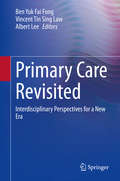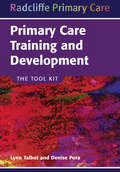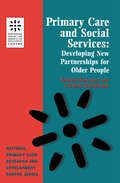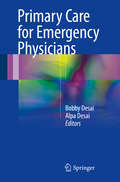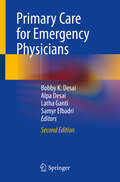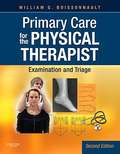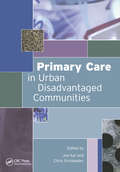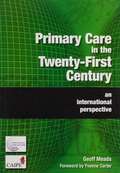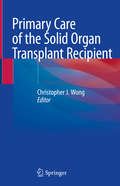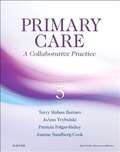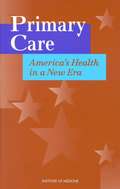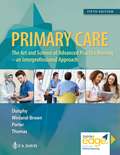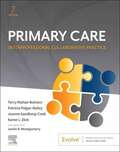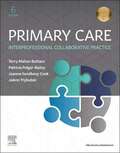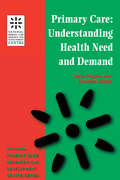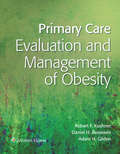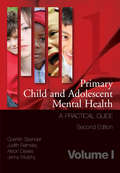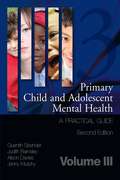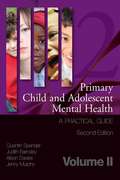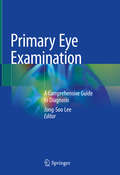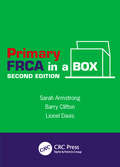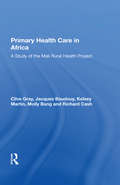- Table View
- List View
Primary Care Revisited: Interdisciplinary Perspectives for a New Era
by Ben Yuk Fai Fong Vincent Tin Sing Law Albert LeeThis book adopts an interdisciplinary approach with a wide scope of perspectives on primary healthcare, describing related principles, care models, practices and social contexts. It combines aspects of development, research and education applied in primary health care, providing practitioners and scholars with a comprehensive overview of the current knowledge and delivery models of healthcare in community settings. It covers the practical, philosophical and scholarly issues pertinent to the delivery, financing, planning, ethics, health politics, professional and technological development, resources, and monitoring in primary health care. Contributors are from a diverse range of academic and professional backgrounds, bringing together collective expertise in mainstream medicine, nursing, allied health, Chinese medicine, health economics, administration, law, public policy, housing management, information technology and mass communications. As such, the book does not follow the common clinical practice or service-based approach found in most texts on primary care.The contents will serve as a useful reference work for policymakers, researchers, community health practitioners, health executives and higher education students.
Primary Care Sleep Medicine
by S. R. Pandi-Perumal James F. PagelPrimary Care Sleep Medicine - A Practical Guide was among the first books to address sleep medicine for a primary care audience. It remains the primary text oriented to the primary care physician with an interest in sleep disorders medicine Since this title published, there have been many changes in the sleep field A new text oriented towards supporting the primary care physician in the practice of sleep medicine is needed; an updated second edition of Primary Care Sleep Medicine - A Practical Guide could fill this knowledge gap. This second edition will include updated information on insomnia medications, post-traumatic stress disorders, home sleep testing protocols, complex sleep apnea and the defined role for primary care physicians in sleep medicine.
Primary Care Training and Development: The Tool Kit
by Lynn Talbot Denise PoraThis new edition of a classic text interprets normal and abnormal laboratory results for the wide range of tests that have become part of everyday clinical practice. Fully updated, it includes new tests, such as PSA velocity and free/total PSA and coeliac serology. New guidelines on specific clinical conditions such as heart failure, management of female infertility, specific lipid monitoring in diabetes and guidance for monitoring heart failure are also outlined.
Primary Care and Social Services: Developing New Partnerships for Older People (National Primary Care Research & Development Centre)
by Kirstein RummeryHealth policy emphasises the role of primary and community-based services in achieving strategic change throughout the NHS. However despite lead roles assigned to social service departments and residential and nursing home care services difficulties remain in achieving closer working relationships. This book is a concise guide to the new initiatives in this area including models and practical examples. It covers the recent developments encouraging partnerships between health and social care services and is essential reading for all those involved in primary care and the social services especially those with an interest in the care of older people. The National Primary Care Research and Development Centre series provides policy makers commissioners managers primary care professionals and user organisations with up-to-date multi-disciplinary research on important issues that inform future decision-making for primary care development.
Primary Care for Emergency Physicians
by Bobby Desai Alpa DesaiThis book is written for physicians who work within an emergency department or urgent care setting to provide them with a treatment plan for those patients who are deemed not to have an emergency medical situation and can be safely treated as an outpatient. Emergency physicians (EPs) see a wide variety of patients and ostensibly for emergency reasons. However, many patients present to the emergency department for primary care-related reasons due to multiple factors or are diagnosed with potentially chronic problems that require a primary care intervention. Examples include a new diagnosis of hypertension (without hypertensive emergency) or diabetes. Thus, it is prudent for the EP to learn about basic primary care management of these conditions. Unfortunately, the training of EPs does not include these conditions, and they are left to guess appropriate treatment or to start a new medication that may not be appropriate. This book aims to fill this gap by educating the EP on basic primary care interventions for specific conditions.
Primary Care for Emergency Physicians
by Latha Ganti Alpa Desai Bobby K. Desai Samyr ElbadriThis book provides emergency department and urgent care physicians with a treatment plan for patients deemed not to have an emergency medical situation and who can be safely treated as an outpatient. Although this book examines a wide variety of conditions and patient demographics, it maintains a consistent narrative that reflects the urgency and specificities of the emergency medicine setting. This book further fills gaps in the emergency medicine literature by relaying deliberate and concise training on how to provide basic primary care. Primary Care for Emergency Physicians utilizes the latest information present in the field to provide the reader with up-to-date diagnosis and treatment for the conditions most often seen in the emergency department. A second edition to its successful predecessor, the book’s original chapters have been thoroughly updated and several new chapters have been added. The new chapters consist of diagnoses, treatments, and general information on diabetes mellitus, vaginal problems, sciatica, and allergic rhinitis. Among the topics carried over from the first edition are headaches, ear pain, sinonasal diseases, GERD, bloating, constipation, and hemorrhoids. This volume is a concise guide to primary care that is ideal for emergency and urgent care physicians, both residents and more experienced providers.
Primary Care for the Physical Therapist: Examination and Triage, Second Edition
by William G. BoissonnaultSpecifically designed to address the expanding role of physical therapists in primary care, the second edition of Primary Care for the Physical Therapist: Examination and Triage provides the information you need to become an effective primary care provider. Acquire the communication and differential diagnosis skills, technical expertise, and clinical decision-making ability to meet the challenges of a changing profession with this unparalleled resource. Emphasizes communication skills vital for establishing rapport and gathering data. Patient interview guides identify what data to collect and how to use it. Overview of the physical examination lays the foundation for different diagnosis and recognition of conditions. A section on Special Populations equips the PT to handle common problems encountered in primary care. Unique approach details pharmacology and diagnostic procedures from a PT perspective for clinically relevant guidance. New information enhances your understanding of the foundations of practice and how to screen and examine the healthy population. Content is reorganized and updated to reflect the current state of PT practice. Companion Evolve resources website enables you to independently review techniques from the text. Top 10 Medical Conditions to Screen For chapter details conditions that have major significance in incidence, mortality, and morbidity all in one place. Separate chapters on upper and lower quarter screening and a new chapter on symptom investigation by symptom help you screen medical conditions more effectively.
Primary Care in Urban Disadvantaged Communities
by Joe Kai Chris DrinkwaterThis approach to a common problem differs from classical texts by concentrating on clear, concise presentations of standard and advanced techniques in inguinal herniorrhaphy, and assumes that the underlying anatomy and pathology is already understood by the reader. It is a high-level reference, written by and for experts in the field.
Primary Care in the Twenty-First Century: An International Perspective
by Geoff MeadsQuality is at the heart of the government's strategy for NHS development, and which is to be delivered through clinical governance. This book explores accreditation through practical case studies and research findings, and outlines how it can assure the quality of care. Systems of accreditation for measuring and improving quality are described, and show how they can be used easily and effectively to meet the challenges of the new NHS. It is clear, concise and relevant to all the current changes in healthcare provision. All those responsible for delivering a service based on clinical and cost effectiveness will find it essential reading. 'In the United Kingdom primary health care is based almost wholly on general practice. From April 1999 all general practices will belong to primary care groups. Questions of quality and accountability will be high on their agenda as part of the new arrangements for clinical governance. This book on accreditation in primary care is therefore most timely.' Sir Donald Irvine, President, General Medical Council, in the Introduction.
Primary Care of the Solid Organ Transplant Recipient
by Christopher J. WongSolid organ transplantation offers a new chance at life to those suffering from failing organs. With these successes, however, comes the everyday management that is required to maintain health. The field of solid organ transplantation has become a part of medicine that generalists should be familiar with, as recipients are living longer and frequently returning to primary care for management. While specialists will still need to be involved with the care of solid organ transplant recipients on a life-long basis, many conditions will still need initial and often ongoing care by generalists, including infections, metabolic conditions, psychiatric illnesses, and malignancy.This book focuses on the care of adult solid organ transplant recipients, and is targeted at the level of the primary care provider. It begins with an introduction and overviews of solid organ transplantation and anti-rejection medications. It then delves into organ-specific chapters that provide the primary care provider with an overview of how to take care of patients with the most commonly-transplanted solid organs: kidney, kidney-pancreas, liver, heart, and lung. The final section focuses on specific complications that arise from transplantation including cancer, metabolic conditions, infections, and common presenting syndromes. Preventative health is also discussed, and the book concludes with a chapter on palliative care. Primary Care of the Solid Organ Transplant Recipient is a unique text that provides the reader with organ and complication-specific sections that can be independently read as they relate to the individual physicians and their patients. Written by experts in the field, this text is a valuable resource for primary care providers, medical students, residents and anyone involved in the care of solid organ transplant recipients.
Primary Care: A Collaborative Practice
by Terry Buttaro JoAnn Trybulski Patricia Polgar-Bailey Joanne Sandberg-CookPrepare for success in today's fast-paced, collaborative healthcare environment! Offering expert perspectives from a variety of primary care and nurse practitioners, Primary Care: A Collaborative Practice, 5th Edition helps you diagnose, treat, and manage hundreds of adult disorders. Care recommendations indicate when to consult with physicians or specialists, and when to refer patients to an emergency facility. This edition includes six new chapters, a fresh new design, the latest evidence-based guidelines, and a new emphasis on clinical reasoning. Combining academic and clinical expertise, an author team led by Terry Mahan Buttaro shows NPs how to provide effective, truly interdisciplinary health care.
Primary Care: America's Health in a New Era
by Committee on the Future of Primary CareAsk for a definition of primary care, and you are likely to hear as many answers as there are health care professionals in your survey. Primary Care fills this gap with a detailed definition already adopted by professional organizations and praised at recent conferences. This volume makes recommendations for improving primary care, building its organization, financing, infrastructure, and knowledge base--as well as developing a way of thinking and acting for primary care clinicians. Are there enough primary care doctors? Are they merely gatekeepers? Is the traditional relationship between patient and doctor outmoded? The committee draws conclusions about these and other controversies in a comprehensive and up-to-date discussion that covers The scope of primary care. Its philosophical underpinnings. Its value to the patient and the community. Its impact on cost, access, and quality. This volume discusses the needs of special populations, the role of the capitation method of payment, and more. Recommendations are offered for achieving a more multidisciplinary education for primary care clinicians. Research priorities are identified. Primary Care provides a forward-thinking view of primary care as it should be practiced in the new integrated health care delivery systems--important to health care clinicians and those who train and employ them, policymakers at all levels, health care managers, payers, and interested individuals.
Primary Care: Art And Science Of Advanced Practice Nursing
by Lynne M. Dunphy Jill E. Winland-Brown Brian Oscar Porter Debera J. ThomasServes the needs of advanced practice nurses because it’s written by nurse practitioners for nurse practitioners, in collaboration with a physician. Organizes content around the Circle of Caring framework for nursing-based knowledge and holistic care. Explores complementary and alternative treatments for each disorder. Covers the broadest range of human disease and disorders using a systems-based approach, presenting both common complaints and common problems to help students narrow down the possible differentials to the most likely diagnosis. Considers interactions of pharmaceuticals with alternative medications and nutraceuticals. Features coverage of pathophysiology and diagnostic reasoning as well as up-to-date guidance on laboratory and diagnostic tests. Emphasizes evidence-based practice with information on evidence levels and more references to primary studies. Integrates discussions of health policy and primary care throughout the text.
Primary Care: Interprofessional Collaborative Practice
by Buttaro Terry Mahan; Polgar-Bailey Patricia Sandberg-Cook Joanne Dick Karen L. Mont Justin BThere’s no better preparation for Nurse Practitioners and other adult primary care practitioners! Buttaro’sPrimary Care: Interprofessional Collaborative Practice, 7th Edition provides the concise yet thorough information that you need in today's fast-paced, interprofessional, collaborative environment. With authorship reflecting both academic and clinical expertise, this comprehensive, evidence-based primary care text/reference shows you how to deliver effective, truly interdisciplinary health care. It covers every major adult disorder seen in the outpatient office setting and features a unique interprofessional collaborative approach with referral and “Red Flag” highlights and more. New to this edition are chapters on health equity, public health preparedness, endocannabinoids, and self-care.
Primary Care: Interprofessional Collaborative Practice
by Terry Mahan Buttaro JoAnn Trybulski Patricia Polgar-Bailey Joanne Sandberg-CookThere’s no better preparation for Nurse Practitioners and others in the adult primary care field! Primary Care: Interprofessional Collaborative Practice, 6th Edition provides the concise yet thorough information that you need in today's fast-paced, interprofessional, collaborative environment. With authorship reflecting both academic and clinical expertise, this comprehensive, evidence-based primary care text/reference shows you how to deliver effective, truly interdisciplinary health care. It covers every major adult disorder seen in the outpatient office setting and features a unique interprofessional collaborative approach with referral/consultation highlights and more. New to this edition is an increased emphasis on rationales for recommendations, pharmacotherapeutics and drug decision-making, and diagnostic direction providing guidance in management, prescribing medications, and ordering diagnostic tests.
Primary Care: Understanding Health Need and Demand
by Anne Rogers Heather Eliott'How many general practitioners ended up in their roles thanks to a faint breeze nudging them in a given direction? How many successes resulted from failure? Some of the most successful practices were built up from nothing, and some of the happiest doctors spent time not being doctors. Despite the element that fate plays in career paths it is prudent to make plans - ' A career in general practice offers many options for further professional development. While some GPs prefer to concentrate primarily on their practice, others find additional fulfillment in teaching, research or international collaboration. Whichever path you choose, general practice promises a rewarding and exciting experience. This inspiring new book emphasises there is no single career path in general practice. Without being prescriptive, its practical approach helps you make life-changing decisions, prompts self-analysis and equips you with the tools to remain flexible, positive and reflective about your career. 'So - have you got what it takes to practise the 'medicine plus' which is today's general practice? This book, written and edited by colleagues many of whom have far more street cred than I, will help you decide. If you have, I wish you luck, fulfilment, and the gratification that comes from being a catalyst for good in the lives of your fellow human beings. If you have a role teaching and mentoring the next generation of GPs, you will find this book a persuasive ally. But if you decide that hospital medicine is your preferred option - well, that's fine. There would be no shame, if you find the ladder to general practice too steep, in settling for becoming a brain surgeon.' Roger Neighbour, in the Foreword 'Lively, extremely informative and engaging' Professor Roger Jones, Editor, British Journal of General Practice
Primary Care:Evaluation and Management of Obesity
by Robert KushnerWritten by and for primary care professionals, this unique title presents step-by-step, evidence-based information for the assessment and treatment of patients who present with overweight or obesity. Highly practical and easy to use, Primary Care: Obesity helps you develop and hone the specific knowledge, skills, and clinical practices necessary to provide effective care to this highly prevalent and at-risk patient population. This comprehensive guide is an essential resource for today’s internal medicine and family medicine physicians, pediatricians, nurse practitioners, physician assistants, and other healthcare professionals who practice outpatient primary care.
Primary Central Nervous System Tumors
by David A. Reardon Andrew D. Norden Patrick C. WenThis comprehensive, yet practical, text is a ready collection of the most up-to-date information on primary CNS tumors. Authored by a carefully selected group of the world's leading clinicians and scientists, the book is divided into three sections. The opening chapters cover general principles, including epidemiology, pathogenesis, tumor stem cells, supportive care, complications of therapy, and quality of life. The remaining two sections are comprised of treatment-oriented chapters covering the spectrum of gliomas and rarer tumor types. Each of these chapters presents multi-disciplinary therapeutic approaches and addresses specific disease concerns. Throughout, the authors incorporate the cutting-edge advances in molecular biology and genomics that are revolutionizing neuro-oncology. The result is an important clinical resource which provides evidence-based data and interpretation essential to intelligent therapeutic decision making.
Primary Child and Adolescent Mental Health: A Practical Guide, Volume 1
by Alison Davies Quentin Spender Judith Barnsley Jenny MurphyRewritten with the new primary care environment in mind, this greatly expanded and updated edition of Child Mental Health in Primary Care extends the structured approach of the first edition to adoelscent mental health. As in the first edition, Primary Child and Adolescent Mental Health covers each problem in a uniform way, offering definitions, assessment outlines, detailed management options and indications for referral. Numerous case examples further illuminate aspects of many conditions. Comprehensive and practical, the forty-eight chapters of Primary Child and Adolescent Mental Health cover the full range of difficulties and disabilities affecting the mental health of children and young people. The book is divided into three volumes, and can either be read from cover to cover or used as a resource to be consulted for guidance on specific problems. This book is vital for all healthcare professionals including general practitioners, health visitors and other staff working in primary care to assess, manage and refer children and adolescents with mental health problems. School medical officers, social workers and educational psychologists, many of whom are in the front line of mental health provision for children and young people, will also find it extremely useful. Reviews of the first edition: 'This very comprehensive and detailed book provides the tools for primary care health professionals not only to assess a child's needs but in many cases also to implement an initial package of care.' JUST FOR NURSES 'I have no reservation in recommending the book to all people working with children and families in any capacity. An important training text for a variety of professions. A very effective text to be used in daily practice for quick reference.' CHILD AND ADOLESCENT MENTAL HEALTH 'This book is well produced and clearly written. A useful book for anyone interested or involved with children.' FAMILY PRACTICE 'I looked through the book again and again but could not find anything missing.' NURSING TIMES
Primary Child and Adolescent Mental Health: A Practical Guide, Volume 3
by Alison Davies Quentin Spender Judith Barnsley Jenny MurphyRewritten with the new primary care environment in mind, this greatly expanded and updated edition of Child Mental Health in Primary Care extends the structured approach of the first edition to adoelscent mental health. As in the first edition, Primary Child and Adolescent Mental Health covers each problem in a uniform way, offering definitions, assessment outlines, detailed management options and indications for referral. Numerous case examples further illuminate aspects of many conditions. Comprehensive and practical, the forty-eight chapters of Primary Child and Adolescent Mental Health cover the full range of difficulties and disabilities affecting the mental health of children and young people. The book is divided into three volumes, and can either be read from cover to cover or used as a resource to be consulted for guidance on specific problems. This book is vital for all healthcare professionals including general practitioners, health visitors and other staff working in primary care to assess, manage and refer children and adolescents with mental health problems. School medical officers, social workers and educational psychologists, many of whom are in the front line of mental health provision for children and young people, will also find it extremely useful. Reviews of the first edition: 'This very comprehensive and detailed book provides the tools for primary care health professionals not only to assess a child's needs but in many cases also to implement an initial package of care.' JUST FOR NURSES 'I have no reservation in recommending the book to all people working with children and families in any capacity. An important training text for a variety of professions. A very effective text to be used in daily practice for quick reference.' CHILD AND ADOLESCENT MENTAL HEALTH 'This book is well produced and clearly written. A useful book for anyone interested or involved with children.' FAMILY PRACTICE 'I looked through the book again and again but could not find anything missing.' NURSING TIMES
Primary Child and Adolescent Mental Health: A Practical Guide,Volume 2
by Alison Davies Quentin Spender Judith Barnsley Jenny MurphyRewritten with the new primary care environment in mind, this greatly expanded and updated edition of Child Mental Health in Primary Care extends the structured approach of the first edition to adoelscent mental health. As in the first edition, Primary Child and Adolescent Mental Health covers each problem in a uniform way, offering definitions, assessment outlines, detailed management options and indications for referral. Numerous case examples further illuminate aspects of many conditions. Comprehensive and practical, the forty-eight chapters of Primary Child and Adolescent Mental Health cover the full range of difficulties and disabilities affecting the mental health of children and young people. The book is divided into three volumes, and can either be read from cover to cover or used as a resource to be consulted for guidance on specific problems. This book is vital for all healthcare professionals including general practitioners, health visitors and other staff working in primary care to assess, manage and refer children and adolescents with mental health problems. School medical officers, social workers and educational psychologists, many of whom are in the front line of mental health provision for children and young people, will also find it extremely useful. Reviews of the first edition: 'This very comprehensive and detailed book provides the tools for primary care health professionals not only to assess a child's needs but in many cases also to implement an initial package of care.' JUST FOR NURSES 'I have no reservation in recommending the book to all people working with children and families in any capacity. An important training text for a variety of professions. A very effective text to be used in daily practice for quick reference.' CHILD AND ADOLESCENT MENTAL HEALTH 'This book is well produced and clearly written. A useful book for anyone interested or involved with children.' FAMILY PRACTICE 'I looked through the book again and again but could not find anything missing.' NURSING TIMES
Primary Eye Examination: A Comprehensive Guide to Diagnosis
by Jong-Soo LeeThis book is a comprehensive, in-depth, and up-to-date resource on eye examination that will be of great practical value for ophthalmologists and optometrists. The aim is to guide the practitioner through the diagnostic process and the implications for management of the ocular patient, and in so doing to demonstrate that it is possible to reach appropriate decisions on the basis of eye examination. Every year, existing ocular equipment is being upgraded and new diagnostic equipment is appearing on the market. This book reflects recent progress in upgrading by providing information and guidance on the latest innovations in ocular examination and eye testing while also highlighting the continuing important role of the traditional eye test. The coverage accordingly ranges from such long-established techniques as ophthalmoscopy, tonometry, and slit lamp examination through to the latest advances in OCT technologies, digital fundus photography, confocal scanning laser ophthalmoscopy, ocular ultrasound, and angiography. The authors hope that the book will assist all practitioners who perform ophthalmologic examinations.
Primary FRCA in a Box, Second Edition
by Sarah Armstrong Barry Clifton Lionel DavisPrimary FRCA in a Box 2e contains over 200 revision flashcards addressing all the topics needed to pass the Primary FRCA. The key subject areas of physiology, pharmacology, physics, and anatomy are covered in easy-to-learn note format. Illustrations aid understanding making this particularly suited to the viva examination. Using standard question formats from the Royal College exams, Primary FRCA in a Box 2e is an essential tool for effective revision and preparation for the Primary FRCA exams.Recommended for all qualified and trainee anaesthetists and their trainers, and related health professionals.
Primary FRCA: OSCEs in Anaesthesia
by Andrew Davies Simon Maguire William Simpson Peter Frank Andrew Davies William Simpson Peter FrankAre you frustrated by the lack of lack of quality, up-to-date revision material for the Primary FRCA OSCE examination? The answer is here. Primary FRCA: OSCEs in Anaesthesia provides candidates with over 80 practice OSCE stations presented in the style of the Royal College exam. Covering the main OCSE categories such as physical examination, resuscitation and simulation, anaesthetic hazards, and equipment, this book will help candidates prepare for the exam and test their knowledge. Each station is constructed in clear and logical fashion to make the revision of individual topics more accessible. The sample questions and answers allow self-testing and are complemented by discussions, numerous illustrations and up-to-date clinical guidelines which follow modern-day anaesthetic practice. With more candidates now failing the OSCE component of the exam, Primary FRCA: OSCEs in Anaesthesia is a must-have for trainees and tutors preparing for the primary FRCA.
Primary Health Care In Africa: A Study Of The Mali Rural Health Project
by Molly Bang Clive Gray Jacques Baudouy Kelsey MartinThe Mali Rural Health Project was designed as a model effort within the US foreign aid programme for extending rudimentary health services in rural areas of developing nations. Although some success was achieved, the programme proved to be too costly for nation-wide implementation, thus failing to achieve its immediate goals. The authors' assessmen
